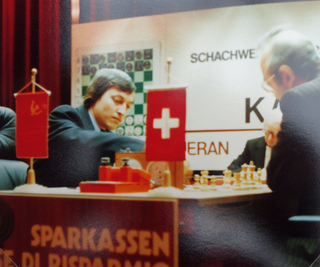The French Defence is a chess opening characterised by the moves:
The Ruy Lopez, also called the Spanish Opening or Spanish Game, is a chess opening characterised by the moves:
In chess, the Smith–Morra Gambit is an opening gambit against the Sicilian Defence distinguished by the moves:
The Grünfeld Defence is a chess opening characterised by the moves:
The Pirc Defence is a chess opening characterised by the response of Black to 1.e4 with 1...d6 and 2...Nf6, followed by ...g6 and ...Bg7, while allowing White to establish a centre with pawns on d4 and e4. It is named after the Slovenian grandmaster Vasja Pirc.
The Modern Defense is a hypermodern chess opening in which Black allows White to occupy the center with pawns on d4 and e4, then proceeds to attack and undermine this "ideal" center without attempting to occupy it.
The King's Indian Defence is a common chess opening. It is defined by the following moves:
The Dutch Defence is a chess opening characterised by the moves:
Bird's Opening is a chess opening characterised by the move:
The Queen's Pawn Game is any chess opening starting with the move:
The Stonewall Attack is a chess opening characterized by White playing pawns to d4 and e3, bishop to d3, knight to d2, and then completing the Stonewall structure by playing pawns to c3 and f4. This set-up is usually achieved by a 1.d4 move order but transposition is also possible via Bird's Opening, 1.f4. The Stonewall Attack is a system; White heads for a very specific pawn formation, rather than trying to memorize long lines of different variations. Black can set up in various ways in response, but MCO-15 gives the following as a main line: 1.d4 d5 2.e3 Nf6 3.Bd3 c5 4.c3 Nc6 5.f4.
In the game of chess, Indian Defence or Indian Game is a broad term for a group of openings characterised by the moves:
In chess, the Dragon Variation is one of the main lines of the Sicilian Defence and begins with the moves:
The London System is an opening system in chess where White opens with 1.d4 and develops the dark-squared bishop to f4, then supports the d4-pawn with pawns on e3 and c3. The other bishop is developed to d3 and the knights typically to f3 and d2. This set-up often results in a closed game. The London System can be used against virtually any Black defence and thus comprises a smaller body of opening theory than many other openings. Although it has a reputation as a solid opening, the London System has faced criticism for its tedious nature and lack of dynamic play.

The World Chess Championship 1886 was the first official World Chess Championship match contested by Wilhelm Steinitz and Johannes Zukertort. The match took place in the United States from 11 January to 29 March, the first five games being played in New York City, the next four being played in St. Louis and the final eleven in New Orleans. The winner was the first player to achieve ten wins. Wilhelm Steinitz won the match 10–5, winning his tenth game in the twentieth game of the match. There were five draws.

The third World Chess Championship was held in New York City from 9 December 1890 to 22 January 1891. Holder Wilhelm Steinitz narrowly defeated his Hungarian challenger, Isidor Gunsberg.

The 1981 World Chess Championship was played between Anatoly Karpov and Viktor Korchnoi in Merano, Italy from October 1 to November 19, 1981. Karpov won with six wins against two, with 10 draws. The two players had already played against each other in the World Chess Championship match 1978 in the Philippines, when Karpov also won.
The 1992 Fischer–Spassky match was a chess match between former world chess champions Bobby Fischer and Boris Spassky. It was billed as a World Chess Championship, though it was an unofficial rematch of their 1972 World Championship match. Fischer won 10–5, with 15 draws. Although there was substantial media coverage, and some drama, public interest in this rematch was not nearly as great as with the 1972 World Championship match in Reykjavík, Iceland.


